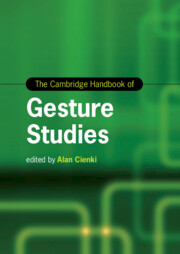Book contents
- The Cambridge Handbook of Gesture Studies
- Cambridge Handbooks in Language and Linguistics
- The Cambridge Handbook of Gesture Studies
- Copyright page
- Contents
- Figures
- Tables
- Contributors
- Introduction
- Part I Gestural Types: Forms and Functions
- Part II Ways of Approaching Gesture Analysis
- Part III Gestures and Language
- Part IV Gestures in Relation to Cognition
- 18 The Growth Point
- 19 Gestures in Cognition: Actions that Bridge the Mind and the World
- 20 The Neuroscience of Gesture Production
- 21 Gesture in Learning and Education
- Part V Gestures in Relation to Interaction
- Index
- References
20 - The Neuroscience of Gesture Production
from Part IV - Gestures in Relation to Cognition
Published online by Cambridge University Press: 01 May 2024
- The Cambridge Handbook of Gesture Studies
- Cambridge Handbooks in Language and Linguistics
- The Cambridge Handbook of Gesture Studies
- Copyright page
- Contents
- Figures
- Tables
- Contributors
- Introduction
- Part I Gestural Types: Forms and Functions
- Part II Ways of Approaching Gesture Analysis
- Part III Gestures and Language
- Part IV Gestures in Relation to Cognition
- 18 The Growth Point
- 19 Gestures in Cognition: Actions that Bridge the Mind and the World
- 20 The Neuroscience of Gesture Production
- 21 Gesture in Learning and Education
- Part V Gestures in Relation to Interaction
- Index
- References
Summary
The chapter presents and discusses empirical data on the neuropsychology of gesture production. The focus of this chapter is on the specific contributions of the right and left hemispheres to the generation of gestures. Since the respective neuroscientific method has a substantial impact on the study results and different methodologies can even entail apparently opposing results concerning gesture production, different neuropsychological methods, their paradigms, and limitations are presented in detail. Spontaneous gesture production studies evidence a substantial contribution of the right hemisphere to gesture production, while gesture production on command studies show a relevant role of the left hemisphere. Gestures that are generated in association with right hemispheric functions such as spatial cognition, nonverbal emotional expression, global and metaphorical thinking appear to be generated in the right hemisphere, while gestures that are linked to tool use praxis are generated in the left hemisphere. The findings further provide a neuropsychological basis for understanding the complementarity but also the dissociation between gestural and verbal message.
Keywords
Information
- Type
- Chapter
- Information
- The Cambridge Handbook of Gesture Studies , pp. 525 - 555Publisher: Cambridge University PressPrint publication year: 2024
